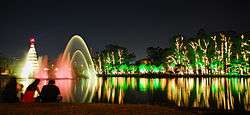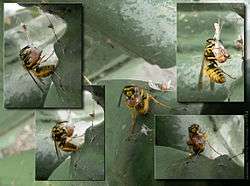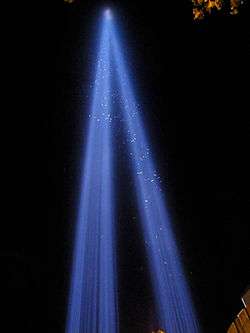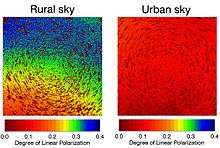Ecological light pollution
Ecological light pollution is the effect of artificial light on individual organisms and on the structure of ecosystems as a whole.
.png)

The effect that artificial light has upon organisms is highly variable,[1] and ranges from beneficial (e.g. increased ability for predator species to observe prey) to immediately fatal (e.g. moths that are attracted to incandescent lanterns and are killed by the heat). It is also possible for light at night to be both beneficial and damaging for a species. As an example, humans benefit from using indoor artificial light to extend the time available for work and play, but the light disrupts the human circadian rhythm, and the resulting stress is damaging to health.[2]
Through the various effects that light pollution has on individual species, the ecology of regions is affected. In the case where two species occupy an identical niche, the population frequency of each species may be changed by the introduction of artificial light if they are not equally affected by light at night. For example, some species of spiders avoid lit areas, while other species are happy to build their spider web directly on a lamp post. Since lamp posts attract many flying insects,[4] the spiders that don't mind light gain an advantage over the spiders that avoid it, and consequently become more common. Changes in these species frequencies can then have knock-on effects, as the interactions between these species and others in the ecosystem are affected and food webs are altered. These ripple effects can eventually affect even diurnal plants and animals. As an example, changes in the activity of night active insects can change the survival rates of night blooming plants, which may provide food or shelter for diurnal animals.
The introduction of artificial light at night is one of the most drastic anthropogenic changes to the Earth, comparable to toxic pollution, land use change, and climate change due to increases in the concentration of green house gases.

Natural light cycles
The introduction of artificial light disrupts several natural light cycles that arise from the movements of the Earth, Moon, and Sun, as well as from meteorological factors.
Diurnal (solar) cycle
The most obvious change in introducing light at night is the end of darkness in general. The day/night cycle is probably the most powerful environmental behavioral signal, as almost all animals can be categorized as nocturnal or diurnal. If a nocturnal animal is only active in extreme dark, it will be unable to live in lit areas. The most acute affects are directly next to streetlights and lit buildings, but the diffuse light of skyglow can extend out to hundreds of kilometers away from city centers.
Seasonal (solar) cycles
The axial tilt of the Earth results in seasons outside of the tropics. The change in the length of the day is the key signal for seasonal behavior (e.g. mating season) in non-tropical animals. The presence of light at night can result in "seasons out of time" , changing the behavior and thermoregulation of affected organisms. This effect can be deadly for small mammals in the winter, since when their body acts as if it's summer they don't maintain an adequate winter body temperature to survive winter nights.
Lunar cycles
The behavior of some animals (e.g. coyotes,[5] bats,[6] toads,[7] insects) is keyed to the lunar cycle. Near city centers the level of skyglow often exceeds that of the full moon,[8] so the presence of light at night can alter these behaviors, potentially reducing fitness.
Cloud coverage
In pristine areas, clouds blot out the stars and darken the night sky, resulting in the darkest possible nights. In urban and suburban areas, in contrast, clouds enhance the effect of skyglow,[8] particularly for longer wavelengths.[9] This means that the typical level of light is much higher near cities, but it also means that truly dark nights never occur in these areas.

Effects of light pollution on individual organisms
Insects
The attraction of insects to artificial light is one of the most well known examples of the effect of light at night on organisms. When insects are attracted to lamps they can be killed by exhaustion or contact with the lamp itself, and they are also vulnerable to predators like bats.[4]
Insects are affected differently by the varying wavelengths of light, and many species can see ultraviolet and infrared light that is invisible to humans. Because of variances in perception, moths are more attracted to broad spectrum white and bluish light sources than they are to the yellow light emitted by low pressure sodium-vapor lamps.[10]
The compound eye of moths results in fatal attraction to light.[11]
Dragonflies perceive horizontally polarized light as a sign of water. For this reason, sources of water are indistinguishable from asphalt roads with polarized light pollution to them. Dragonflies searching for water either to drink or in which to lay eggs often land on roads or other dark flat reflective surfaces such as cars and remain there until they die of dehydration and hyperthermia.[12]
Light pollution may hamper the mating rituals of fireflies, once they depend on their own light for courtship, resulting in decreased populations.[13][14][15]
Fireflies are charismatic (which is a rare quality amongst insects) and are easily spotted by nonexperts, providing thus good flagship species to attract public attention; good investigation models for the effects of light on nocturnal wildlife; and finally, due to their sensibility and rapid response to environmental changes, good bioindicators for artificial night lighting.[16]
Birds
Lights on tall structures can disorient migrating birds. Estimates by the U.S. Fish and Wildlife Service of the number of birds killed after being attracted to tall towers range from 4 to 5 million per year to an order of magnitude higher. The Fatal Light Awareness Program (FLAP) works with building owners in Toronto, Canada and other cities to reduce mortality of birds by turning out lights during migration periods.

Similar disorientation has also been noted for bird species migrating close to offshore production and drilling facilities. Studies carried out by Nederlandse Aardolie Maatschappij b.v. (NAM) and Shell have led to development and trial of new lighting technologies in the North Sea. In early 2007, the lights were installed on the Shell production platform L15. The experiment proved a great success since the number of birds circling the platform declined by 50–90%.[56] Juvenile seabirds may also be disoriented by lights as they leave their nests and fly out to sea.[17]
Ceilometers (searchlights) can be particularly deadly traps for birds , as they become caught in the beam and risk exhaustion and collisions with other birds. In the worst recorded ceilometer kill-off, on October 7–8, 1954, 50,000 birds from 53 different species were killed at Warner Robins Air Force Base.[18]
Humans
At the turn of the century it was discovered that human eyes contain a non-imaging photosensor that is the primary regulator of the human circadian rhythm.[19] This photosensor is particularly affected by blue light, and when it observes light the pineal gland stops the secretion of melatonin. The presence of light at night in human dwellings (or for shift workers) makes going to sleep more difficult and reduces the overall level of melatonin in the bloodstream, and exposure to a low-level incandescent bulb for 39 minutes is sufficient to suppress melatonin levels to 50%.[20] Because melatonin is a powerful anti-oxidant, it is hypothesized that this reduction can result in an increased risk of breast and prostate cancer.[21][22]
Other human health effects may include increased headache incidence, worker fatigue, medically defined stress, decrease in sexual function and increase in anxiety.[23][24][25][26] Likewise, animal models have been studied demonstrating unavoidable light to produce adverse effect on mood and anxiety.[27]
Turtles
Lights from seashore developments repel nesting Sea turtle mothers, and their hatchlings are fatally attracted to street and hotel lights rather than to the ocean.[28]
Zooplankton
Zooplankton (e.g. Daphnia) exhibit diel vertical migration. That is, they actively change their vertical position inside of lakes throughout the day. In lakes with fish, the primary driver for their migration is light level, because small fish visually prey on them. The introduction of light through skyglow reduces the height to which they can ascend during the night.[29] Because zooplankton feed on the phytoplankton that form algae, the decrease in their predation upon phytoplankton may increase the chance of algal blooms, which can kill off the lakes' plants and lower water quality.
Effects of different wavelengths
The effect that artificial light has upon organisms is wavelength dependent. While human beings cannot see ultraviolet light, it is often used by entomologists to attract insects. Generally speaking, blue light is more likely to be damaging to mammals because the non-imaging photoreceptors in mammalian eyes are most sensitive in the blue region.[30] This means that if traditional vapor discharge streetlamps are replaced by white LEDs (which generally emit more of their radiation in the blue part of the spectrum), the ecological impact could be greater even if the total amount of radiated light is decreased.[31]
Polarized light pollution

Artificial planar surfaces, such as glass windows or asphalt reflect highly polarized light. Many insects are attracted to polarized surfaces, because polarization is usually an indicator for water. This effect is called polarized light pollution,[32] and although it is certainly a form of ecological photopollution, "ecological light pollution" usually refers to the impact of artificial light on organisms.
In the night, the polarization of the moonlit sky is very strongly reduced in the presence of urban light pollution, because scattered urban light is not strongly polarized.[33] Since polarized moonlight is believed to be used by many animals for navigation, this screening is another negative effect of light pollution on ecology.
References
- Catherine Rich; Travis Longcore (2006). Ecological consequences of artificial night lighting. Island Press. ISBN 978-1-55963-128-0.
- Chepesiuk, R (2009). "Missing the Dark: Health Effects of Light Pollution". Environmental Health Perspectives. 117 (1): A20–7. doi:10.1289/ehp.117-a20. PMC 2627884. PMID 19165374.
- Rydell, J (1992). "Exploitation of Insects around Streetlamps by Bats in Sweden". Functional Ecology. 6 (6): 744–750. doi:10.2307/2389972. JSTOR 2389972.
- Bender, Darren J; Bayne, Erin M; Brigham, R. Mark (1996). "Lunar Condition Influences Coyote (Canis latrans) Howling". American Midland Naturalist. 136 (2): 413–417. doi:10.2307/2426745. JSTOR 2426745.
- Gannon, Michael R; Willig, Michael R (1997). "The Effect of Lunar Illumination on Movement and Activity of the Red Fig-eating Bat (Stenoderma rufum)". Biotropica. 29 (4): 525–529. doi:10.1111/j.1744-7429.1997.tb00048.x. JSTOR 2388947.
- Rachel A. Granta; Elizabeth A. Chadwick; Tim Halliday (2009). "The lunar cycle: a cue for amphibian reproductive phenology?". Animal Behaviour. 78 (2): 349–357. doi:10.1016/j.anbehav.2009.05.007.
- C. C. M. Kyba; T. Ruhtz; J. Fischer; F. Hölker (2011). "Cloud Coverage Acts as an Amplifier for Ecological Light Pollution". PLoS ONE. 6 (3): e17307. Bibcode:2011PLoSO...617307K. doi:10.1371/journal.pone.0017307. PMC 3047560. PMID 21399694.
- Kyba, C. C. M.; Ruhtz, T.; Fischer, J.; Hölker, F. (1 September 2012). "Red is the new black: how the colour of urban skyglow varies with cloud cover". Monthly Notices of the Royal Astronomical Society. 425 (1): 701–708. Bibcode:2012MNRAS.425..701K. doi:10.1111/j.1365-2966.2012.21559.x.
- Gray, R. (29 May 2013). "Fatal Attraction: Moths Find Modern Street Lamps Irresistible". Online Newspaper. The Telegraph. Retrieved 15 November 2014.
- Kenneth D. Frank (1988). "Impact of outdoor lighting on moths". Journal of the Lepidopterists' Society. 42: 63–93. Archived from the original on 2006-06-17.
- "Polarized Light Pollution Leads Animals Astray". UPI Space Daily. United Press International. 13 January 2009.
- Blinder, Alan (August 14, 2014). "The Science in a Twinkle of Nighttime in the South". New York Times. Retrieved August 18, 2014.
- Owens, Avalon Celeste Stevahn; Meyer-Rochow, Victor Benno; Yang, En-Cheng (2018-02-07). "Short- and mid-wavelength artificial light influences the flash signals of Aquatica ficta fireflies (Coleoptera: Lampyridae)". PLOS ONE. 13 (2): e0191576. Bibcode:2018PLoSO..1391576O. doi:10.1371/journal.pone.0191576. ISSN 1932-6203. PMC 5802884. PMID 29415023.
- Firebaugh, Ariel; Haynes, Kyle J. (2016-12-01). "Experimental tests of light-pollution impacts on nocturnal insect courtship and dispersal". Oecologia. 182 (4): 1203–1211. Bibcode:2016Oecol.182.1203F. doi:10.1007/s00442-016-3723-1. ISSN 0029-8549. PMID 27646716.
- Viviani, Vadim Ravara; Rocha, Mayra Yamazaki; Hagen, Oskar (June 2010). "Bioluminescent beetles (Coleoptera: Elateroidea: Lampyridae, Phengodidae, Elateridae) in the municipalities of Campinas, Sorocaba-Votorantim and Rio Claro-Limeira (SP, Brazil): biodiversity and influence of urban sprawl". Biota Neotropica. 10 (2): 103–116. doi:10.1590/S1676-06032010000200013. ISSN 1676-0603.
- RodrÍguez, Airam; RodrÍguez, Beneharo (2009). "Attraction of petrels to artificial lights in the Canary Islands: effects of the moon phase and age class". Ibis. 151 (2): 299–310. doi:10.1111/j.1474-919X.2009.00925.x. hdl:10261/45133.
- Johnston, D; Haines (1957). "Analysis of Mass Bird Mortality in October, 1954". The Auk. 74 (4): 447–458. doi:10.2307/4081744. JSTOR 4081744.
- Provencio, Ignacio; Rodriguez, Ignacio R.; Jiang, Guisen; Hayes, William Pär; Moreira, Ernesto F.; Rollag, Mark D. (2000). "A Novel Human Opsin in the Inner Retina". The Journal of Neuroscience. 20 (2): 600–605. doi:10.1523/JNEUROSCI.20-02-00600.2000. PMC 6772411. PMID 10632589.
- Schulmeister, K.; Weber, M.; Bogner, W.; Schernhammer, E. (2002). "Application of melatonin action spectra on practical lighting issues". Final Report. The Fifth International LRO Lighting Research Symposium, Light and Human Health. Archived from the original on 2016-08-18. Retrieved 2016-08-01.
- Scott Davis; Dana K. Mirick; Richard G. Stevens (2001). "Night Shift Work, Light at Night, and Risk of Breast Cancer". Journal of the National Cancer Institute. 93 (20): 1557–1562. doi:10.1093/jnci/93.20.1557. PMID 11604479.
- Eva S. Schernhammer; Francine Laden; Frank E. Speizer; Walter C. Willett; David J. Hunter; Ichiro Kawachi; Graham A. Colditz (2001). "Rotating Night Shifts and Risk of Breast Cancer in Women Participating in the Nurses' Health Study". Journal of the National Cancer Institute. 93 (20): 1563–1568. doi:10.1093/jnci/93.20.1563. PMID 11604480.
- Susan L. Burks, Managing your Migraine, Humana Press, New Jersey (1994) ISBN 0-89603-277-9
- Cambridge Handbook of Psychology, Health and Medicine, edited by Andrew Baum, Robert West, John Weinman, Stanton Newman, Chris McManus, Cambridge University Press (1997) ISBN 0-521-43686-9
- L. Pijnenburg, M. Camps and G. Jongmans-Liedekerken, Looking closer at assimilation lighting, Venlo, GGD, Noord-Limburg (1991)
- Knez, I (2001). "EFFECTS OF COLOUR OF LIGHT ON NONVISUAL PSYCHOLOGICAL PROCESSES". Journal of Environmental Psychology. 21 (2): 201–208. doi:10.1006/jevp.2000.0198.
- Fonken, L K; Finy, M S; Walton, James C.; Weil, Zachary M.; Workman, Joanna L.; Ross, Jessica; Nelson, Randy J. (28 December 2009). "Influence of light at night on murine anxiety- and depressive-like responses". Behavioural Brain Research. 205 (2): 349–354. doi:10.1016/j.bbr.2009.07.001. PMID 19591880.
- M. Salmon (2003). "Artificial night lighting and sea turtles" (PDF). Biologist. 50: 163–168.
- Marianne V. Moore; Stephanie M. Pierce; Hannah M. Walsh; Siri K. Kvalvik; Julie D. Lim (2000). "Urban light pollution alters the diel vertical migration of Daphnia" (PDF). Verh. Internat. Verein. Limnol. 27: 1–4.
- Falchi, F; Cinzano P; Elvidge CD; Keith DM; Haim A (2011). "Limiting the impact of light pollution on human health, environment and stellar visibility". Journal of Environmental Management. in press (10): 2714–2722. doi:10.1016/j.jenvman.2011.06.029. PMID 21745709.
- International Dark-Sky Association (2010). "Visibility, Environmental, and Astronomical Issues Associated with Blue-Rich White Outdoor Lighting" (PDF). IDA White Paper. Archived from the original (PDF) on 2011-08-14. Retrieved 2011-08-20.
- Horváth, Gábor; György Kriska; Péter Malik; Bruce Robertson (August 2009). "Polarized light pollution: a new kind of ecological photopollution". Frontiers in Ecology and the Environment. 7 (6): 317–325. doi:10.1890/080129.
- Kyba, C. C. M.; Ruhtz, T.; Fischer, J.; Hölker, F. (17 December 2011). "Lunar skylight polarization signal polluted by urban lighting". Journal of Geophysical Research. 116 (D24): n/a. Bibcode:2011JGRD..11624106K. doi:10.1029/2011JD016698.